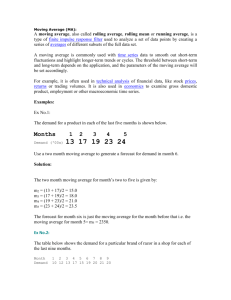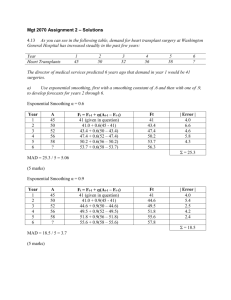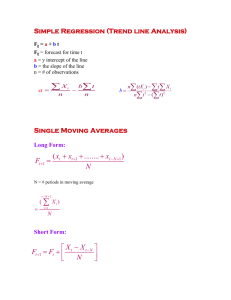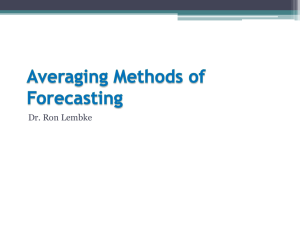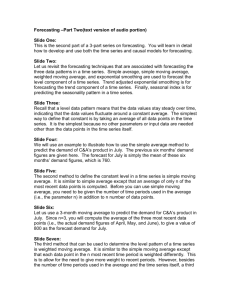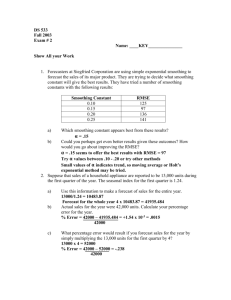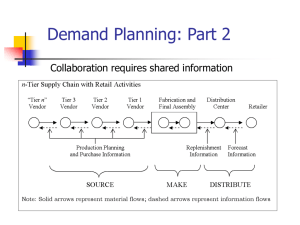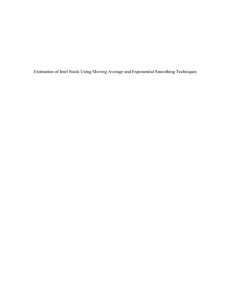Sample Exam #2
advertisement
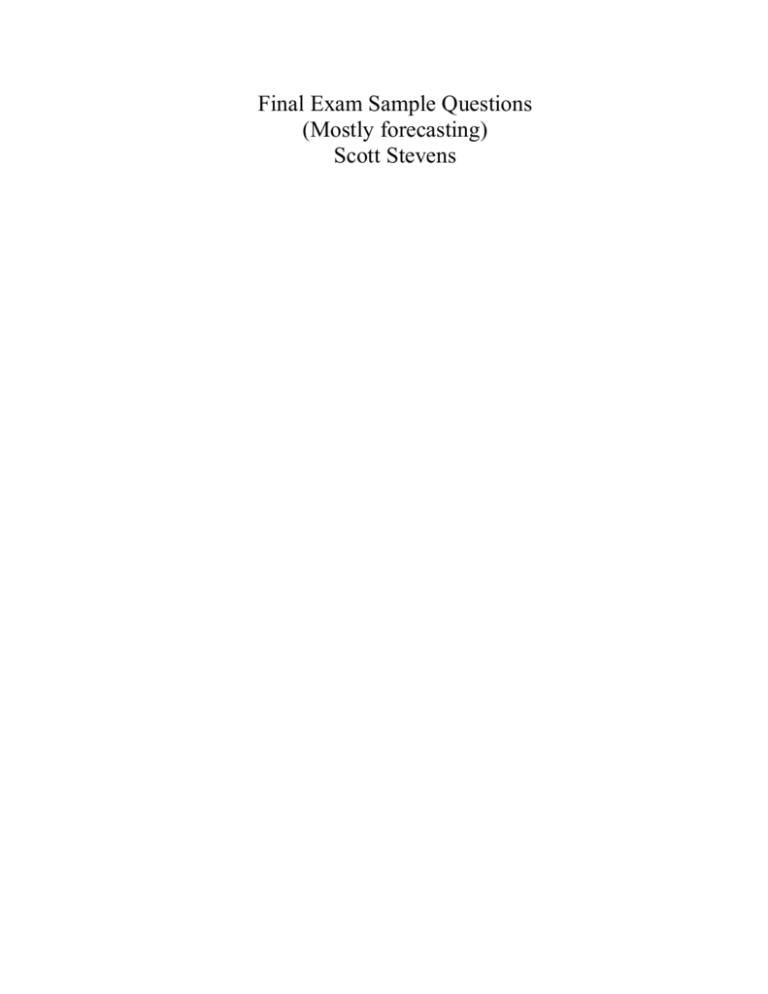
Final Exam Sample Questions (Mostly forecasting) Scott Stevens 1. Which of the following is not one of the four components of a time series, as discussed by your text? a) historical component b) trend component c) irregular component d) seasonal component For questions 2-8, identify the forecasting technique to which the given statement best applies. As a reminder, the “seasonally adjusted trend” is the technique from section 16.4, which we was demonstrated on the last day of class. 1. The technique is able to anticipate a continuing trend. a) simple moving average b) weighted moving average c) exponential smoothing d) linear regression e) all of these techniques can anticipate a continuing trend. 2. The technique allows forecasts for more than one period beyond the final observation. (That is, we could use monthly data from January to May, yet forecast a value for July.) a) simple moving average b) weighted moving average c) exponential smoothing d) seasonally adjusted trend e) none of these can forecast more than one period in advance. 4. This is the simplest technique which allows for the modeling of seasonal variation. a) simple moving average b) weighted moving average c) exponential smoothing d) linear regression e) seasonally adjusted trend 5. This technique results in a forecast which falls farther and farther behind a continuing linear trend. a) simple moving average b) weighted moving average c) exponential smoothing d) linear regression e) seasonally adjusted trend. 6. This is the simplest technique which permits both the anticipation of a continuing trend and the modeling of seasonal variation. a) simple moving average b) weighted moving average c) exponential smoothing d) linear regression e) seasonally adjusted trend 7. This is the easiest of the techniques to explain to the mathematically untrained. a) simple moving average b) weighted moving average c) exponential smoothing d) linear regression e) seasonally adjusted trend 8. The height of the grass in my lawn is approximated by the relation H = 0.14 D + 1.4, where D is the number of days since I have cut my lawn, and H is the height of the grass in inches. I obtained this formula by applying one of our forecasting techniques to observed data. Which technique was probably used? a) simple moving average b) weighted moving average c) exponential smoothing d) linear regression e) seasonally adjusted trend 9. Assume that the height of the grass in my lawn is given by the relation H = 0.14D + 1.4, where D is the number of days since I have cut my lawn, and H is the height of the grass in inches. Which of the following statements is not consistent with this assumption? a) My grass grows over an inch a week. b) I cut my grass to a height of 1.4 inches. c) The height of my grass grows exactly the same amount every day. d) My grass continues to grow taller and taller. e) 1 day after I mow my lawn, my grass is 1.54 inches high. Questions 10-12 refer to the data appearing in the table below. Examine it carefully. w is the weight vector; that is, the weight for the most recent observation in the weighted moving average is 0.8, and so on. You may use the table’s empty cells for your calculations, if you wish. TO SEE MY CALCULATIONS, HIGHLIGHT THE TABLE AND CHOOSE FORMAT/FONT COLOR/AUTOMATIC Period Actual value Simple moving average Exponential smoothing Weighted moving average n=3 n = 3, w = (.8, .1, .1) = .1 1 7 -7 -2 6 -- 7 -- 3 5 -- 6.9 -- 4 7 6 6.71 5.3 5 9 6 6.739 6.7 6 unknown 7 6.965 8.4 10. Find the simple moving average forecast for period 5. It is a) 6 b) 6.25 c) 6.75 d) 7 e) 18 11. Find the exponential smoothing forecast for period 3. It is a) 6.1 b) 6.71 c) 6.9 c) 7 e) 7.1 12. Find the weighted moving average forecast for time period 6. It is a) 7 b) 7.2 c) 7.8 d) 8 e) 8.4 Questions 13-14 refer to the table given below. Period # 1 2 3 4 Actual value 20 18 24 14 Forecast Value 18 14 22 10 13. The MSE for the forecast appearing above is a) 6 b) 10 c) 16 d) 24 e) 40 d) 12 e) 20 14. The MAD for the forecast appearing above is a) 3 b) 5 c) 8 15. a) b) c) d) e) Which if the following statements is not true? MSE is measured in the same units as the values being forecast. Neither MSE nor MAD can ever be negative. MSE penalizes more heavily for large forecast errors than does MAD. MAD stands for “mean absolute deviation”. If MSE = 0, then MAD = 0. Questions 20-22 deal with the following situation: We model domestic fires in a city as a queuing system. A house joins the system when a fire in that house is reported to the fire department. Service consists of a fire truck travelling to the house and putting out the fire. The fire company will respond to a reported fire immediately, unless all fire trucks are already out on calls. Assume only one truck is dispatched to any given fire. Measure time in hours for this problem. 16. a) b) c) d) e) represents the average number of fires reported per hour. the average number of hours required to put out a fire. the average number of hours between two successive fire reports. the fraction of the time that no fire trucks are responding to fires. the fraction of the time a fire truck is busy responding to a call. 17. L represents a) the average number of hours required to put out a fire. b) the average number of fires that the fire company could put out per hour. c) the average number of fire trucks out on call at any given time. d) the average number of reported fires which have not yet been extinguished at any given time. e) the average number of hours passing from the time a fire is reported until the time the fire is extinguished. 18. s represents a) the number of firefighters in the department. b) the number of houses on fire. c) the number of fire trucks in the department. d) the average number of fires put out in a given hour. e) the average number of hours between when a fire is reported and when the fire truck is dispatched. 19. The two management science techniques most widely used by business are a) linear programming and simulation. b) decision trees and forecasting. c) queuing theory and assignment algorithms. d) EVPI and OFCR. e) decision trees and queuing theory. 20. Extend the table of events below to make it into a process generator. Apply this process generator below to the random number 0.2061. This number represents a) wrong number b) busy c) no answer d) hang up e) talk Result of attempted telephone solicitation Wrong number Busy no answer hang up talk Probability .04 .06 .12 .28 .50
